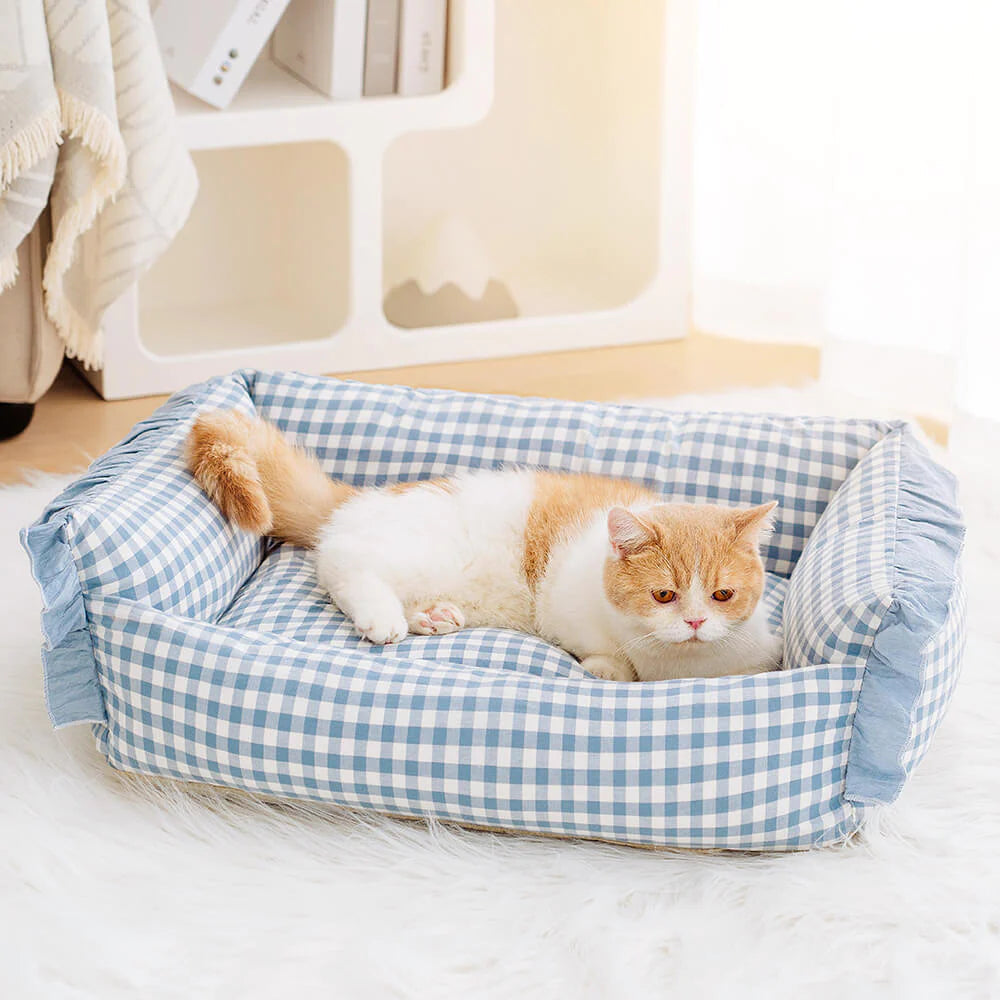Cats are fascinating creatures, known for their unique behaviors, especially when it comes to sleep. As pet owners, it’s important to understand the sleeping habits of domestic cats to create the best possible environment for their rest. A common question many cat owners ask is whether cats prefer to sleep in dark or light spaces. In this blog, we will explore the sleeping patterns of cats, their natural instincts, and how you can cater to their sleeping needs at home.
The Natural Habitat of Cats and Their Sleeping Preferences
To understand cats’ sleeping preferences, it helps to first look at their natural habitat and behavior. Cats are naturally crepuscular animals, which means they are most active during dawn and dusk. This adaptation stems from their evolutionary history as predators—hunting at twilight when their prey is most active.
In the wild, cats typically seek shelter in low-light areas to stay cool and conserve energy. They often find cozy spots under bushes, in shaded areas, or even hidden in trees. This behavior explains why many house cats prefer dimly lit areas to sleep during the day, similar to their wild ancestors.

Cat Sleep Patterns: How Much Do Cats Sleep?
Cats are known for sleeping a lot—on average, adult cats sleep anywhere between 12 to 16 hours per day, and some may even sleep up to 20 hours. While this may seem like an excessive amount of sleep, it's completely normal for cats. Their sleep cycle alternates between light sleep and deep sleep (REM), which is essential for maintaining their energy levels.
When cats are in deep sleep, they are still alert to potential threats around them. This ability to sleep lightly and remain vigilant is one of their key survival instincts. Whether they’re taking a cat nap or curled up in a deep sleep, their sleep cycle allows them to be aware of their surroundings, always ready to spring into action if needed.
Why Cats Sleep So Much
Cats are famous for their remarkable ability to sleep for long stretches, often ranging from 12 to 18 hours a day. While this may seem like an excessive amount of rest, it’s perfectly normal for them and deeply connected to their natural instincts. Cats are crepuscular animals, which means they are most active during the twilight hours of dawn and dusk. This behavior is a reflection of their wild ancestry, where conserving energy during the day was crucial for hunting and playing at night.
Even though domestic cats no longer need to hunt for their food, they still carry the genetic blueprint of their wild ancestors. As solitary hunters, they were designed to rest and conserve energy, ensuring they remain agile and alert when it’s time to pounce. This natural rhythm has stuck with our pet cats, so even though they may not be chasing after prey, their bodies continue to follow this ancient sleep pattern. So, the next time you catch your cat snoozing away, just remember—they're not being lazy, they're simply following their instincts to stay sharp and energized!
Cat Sleeping Positions and What They Mean
Cats have various sleeping positions, each revealing how they feel. A cat curled up in a ball feels secure and comfortable, as this position helps conserve body heat and protect vital organs. Conversely, a cat lying on its back with its belly exposed shows trust and relaxation, as it's a vulnerable position.
Here are some common cat sleeping positions:
-
The Cat Loaf: When a cat tucks its paws under its body, it’s relaxed but alert. They're comfortable and ready to spring into action if needed.
-
The Belly-Up: A cat sleeping on its back with its stomach exposed is showing complete trust and contentment, feeling safe in its environment.
-
Side-Sleeping: Cats that sleep on their sides feel comfortable and secure, allowing them to stretch and fully relax.
Understanding these positions helps you gauge your cat’s comfort and trust, making it easier to create a cozy sleeping environment for them.
Do Cats Prefer Light or Darkness When Sleeping?
The question of whether cats like to sleep in light or darkness depends on individual preferences. While some cats may prefer basking in the sunlight during the day, others seek out darker, quieter places to rest. The preference for light or dark environments is influenced by various factors, such as a cat’s age, breed, and overall personality.
Younger cats, particularly kittens, might enjoy basking in the sun, while older cats, or senior cats, might prefer darker areas where they feel more secure and undisturbed. Domestic cats, in general, have highly sensitive eyes designed to thrive in low-light conditions, thanks to a layer of cells called the tapetum lucidum. This adaptation enhances their night vision, making it easier for them to see in the dark. As a result, many cats may naturally prefer dimly lit or shaded spaces to sleep, helping them avoid discomfort from bright lights.
Preferred Sleeping Spots
Cats are known for their ability to find the cosiest and most comfortable spots to rest. They often choose warm and soft places where they can curl up and feel secure. You may find your cat napping on your bed, a cosy blanket, or even in a secluded corner of the house. Their preferred sleeping spots may vary depending on factors such as temperature, safety, and accessibility.
Factors That Influence Cats’ Light or Dark Sleeping Preferences
Several factors can influence whether cats prefer light or dark spaces when sleeping:
-
Personality: Just like humans, cats have unique personalities. Some cats are more outgoing and love basking in the sunlight, while others are more introverted and prefer darker, more secluded spots.
-
Age: Kittens and senior cats may seek out warmth and coziness in different ways. Senior cats might opt for a more enclosed, dim space to rest comfortably, while younger cats may be more playful and enjoy sunbathing.
-
Breed: Some breeds, such as the Persian or Ragdoll, may have different sleeping preferences compared to other cats. Breeds that are particularly sensitive to temperature might prefer cooler, darker spots.
-
Health: Cats who are stressed or unwell might also seek darker places, as they tend to feel more secure in quieter environments away from noise and distractions.
Cat Sleep and Health
A cat's sleep is more than just a break from play—it's essential to their overall health and well-being. Cats that get enough quality sleep tend to be healthier, more energetic, and happier. On the other hand, those who aren’t getting the rest they need may face a higher risk of health problems and even develop behavioral issues. Several factors can interfere with a cat’s ability to sleep soundly, including:
-
Sleep Disorders: Just like humans, cats can suffer from sleep disorders like insomnia or sleep apnea, which can disrupt their natural sleep cycle and leave them feeling restless.
-
Pain: Physical discomfort from conditions like arthritis or dental issues can make it hard for your cat to find a comfortable sleeping position, preventing them from getting the rest they need.
-
Anxiety: Stressful experiences, such as separation anxiety or fear of loud noises, can lead to a restless night for your cat, leaving them anxious and exhausted.
-
Medical Conditions: Ongoing health problems, such as hyperthyroidism or kidney disease, can directly affect your cat’s ability to fall into a restful sleep.
Making sure your cat gets enough sleep is crucial for their well-being. If you notice any changes in their sleeping habits, or if they seem restless or uncomfortable, it’s always a good idea to consult your vet. Identifying and addressing the cause early on can help ensure that your cat stays happy, healthy, and well-rested.

Creating the Ideal Sleeping Environment for Your Cat
Understanding your cat’s sleeping preferences can help you provide the perfect sleeping environment. Cats love to sleep in spots where they feel safe and comfortable, so offering a variety of options will allow them to choose what suits them best.
Here are some tips for creating an ideal sleeping space for your cat:
-
Provide a range of sleeping areas: Offer both light and dark spaces for your cat to choose from. A warm, sunny spot near a window or a cozy, dimly lit corner could give them the freedom to pick their preferred sleeping environment.
-
Comfortable bedding: Whether your cat prefers light or dark, ensuring they have a soft, cozy bed is essential. Try using semi-enclosed beds or igloo-style cat beds, which allow them to curl up and feel secure.
-
Control light exposure: If you want to simulate natural light cycles indoors, use curtains or blinds to control the amount of light your cat receives. This will help them maintain their natural sleep cycles, whether they prefer light or dark conditions.
Signs of Discomfort or Sleep Disturbances
It’s important to be mindful of any signs that your cat may be uncomfortable with their sleeping conditions. If you notice your cat avoiding certain areas or displaying signs of restlessness during sleep, it could be a signal that the lighting is not ideal for them.
Some signs that your cat may not be comfortable in their sleep environment include:
-
Avoiding certain sleeping spots
-
Increased anxiety or agitation
-
Changes in appetite or behavior
If you notice any of these signs, it may be helpful to adjust the lighting or provide a more enclosed space for your cat to rest.
Conclusion: Understanding Your Cat's Sleep Needs
Every cat is unique, and their preferences for light or darkness during sleep may vary. By paying attention to their natural behaviors and creating a cozy, safe space that suits their needs, you can ensure that your cat gets the restful sleep they require. Whether your cat prefers a sunny spot by the window or a quiet, dark corner, providing them with a variety of options will help them maintain their sleep cycle, stay healthy, and feel secure.
Remember, the key to a happy and healthy cat is understanding their individual needs. If you ever notice unusual sleeping patterns or signs of distress, consult your vet to ensure your cat is comfortable and well-cared for.




